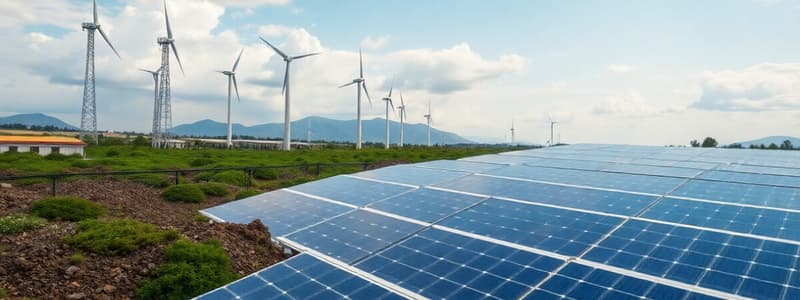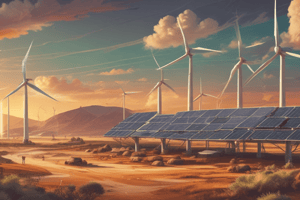Podcast
Questions and Answers
What is the primary characteristic of non-renewable resources?
What is the primary characteristic of non-renewable resources?
Which of the following is NOT a non-renewable resource commonly used for energy?
Which of the following is NOT a non-renewable resource commonly used for energy?
How is crude oil primarily formed?
How is crude oil primarily formed?
Why is it important to conserve non-renewable resources?
Why is it important to conserve non-renewable resources?
Signup and view all the answers
What is one benefit of using renewable energy resources over non-renewable ones?
What is one benefit of using renewable energy resources over non-renewable ones?
Signup and view all the answers
Which conservation method helps reduce the use of non-renewable resources?
Which conservation method helps reduce the use of non-renewable resources?
Signup and view all the answers
What is one negative impact of mining non-renewable resources?
What is one negative impact of mining non-renewable resources?
Signup and view all the answers
What distinguishes renewable resources from non-renewable resources?
What distinguishes renewable resources from non-renewable resources?
Signup and view all the answers
Which of the following is an example of a renewable resource?
Which of the following is an example of a renewable resource?
Signup and view all the answers
How does hydroelectric energy generate electricity?
How does hydroelectric energy generate electricity?
Signup and view all the answers
What is biomass energy primarily derived from?
What is biomass energy primarily derived from?
Signup and view all the answers
What is a key environmental benefit of using biomass energy compared to fossil fuels?
What is a key environmental benefit of using biomass energy compared to fossil fuels?
Signup and view all the answers
What is geothermal energy primarily based on?
What is geothermal energy primarily based on?
Signup and view all the answers
Where are wind turbines most effectively placed?
Where are wind turbines most effectively placed?
Signup and view all the answers
Which statement about renewable resources is true?
Which statement about renewable resources is true?
Signup and view all the answers
Study Notes
Renewable Resources
- Definition: Energy sources that can be replenished at a rate equal to or faster than human use, making them virtually inexhaustible.
-
Examples:
- Solar Energy: Sunlight provides a constant source of heat and light.
- Wind Energy: Wind spins turbine blades, generating electricity. Turbines are typically placed in areas with high wind speeds.
- Hydroelectric Energy: Water movement (rivers, dams) spins turbine blades, creating electricity.
- Biomass Energy: Organic matter (plant/animal waste) burned to create steam & power turbines. Burning biomass emits less CO2 than fossil fuels.
- Geothermal Energy: Heat from Earth's core creates steam to generate electricity.
Non-Renewable Resources
- Definition: Energy sources that cannot be replenished as quickly as they are used. They are finite and deplete over time.
-
Examples:
- Coal: Solid, non-renewable resource formed from decomposed organic matter over millions of years. Used to generate electricity.
- Oil (Petroleum): Liquid fossil fuel used to produce fuels (gasoline, propane, kerosene). Composed of hydrogen and carbon from ancient organisms.
- Natural Gas: Primarily methane, formed from decaying organisms under pressure and heat. Used to generate electricity and heat.
Differences Between Renewable and Non-Renewable Resources
- Formation Time: Non-renewable resources take millions of years to form; renewable resources can be replenished in human lifetimes.
- Sustainability: Renewable resources are continuously replenished; non-renewable resources are finite.
Conservation of Resources
- Importance: Conserving non-renewable resources is crucial due to their finite nature. Recycling and reducing consumption mitigate resource depletion.
-
Methods:
- Reduced Consumption: Turning off lights, unplugging appliances, using ride-sharing services, adjusting thermostats.
- Recycling: Reducing the need to extract new materials from resources.
- Composting: Recycling organic waste reduces resource use.
- Thrift Shopping: Purchasing used items minimizes resource consumption in production.
Benefits of Renewable Resources
- Environmental Impact: Renewable resources produce fewer harmful emissions, mitigating environmental impacts, global warming, and reducing pollution.
Studying That Suits You
Use AI to generate personalized quizzes and flashcards to suit your learning preferences.
Description
Explore the differences between renewable and non-renewable energy sources in this comprehensive quiz. Learn about various examples like solar, wind, and geothermal energy, as well as the limitations of resources like coal and oil. Test your understanding and enhance your knowledge of energy sustainability.





